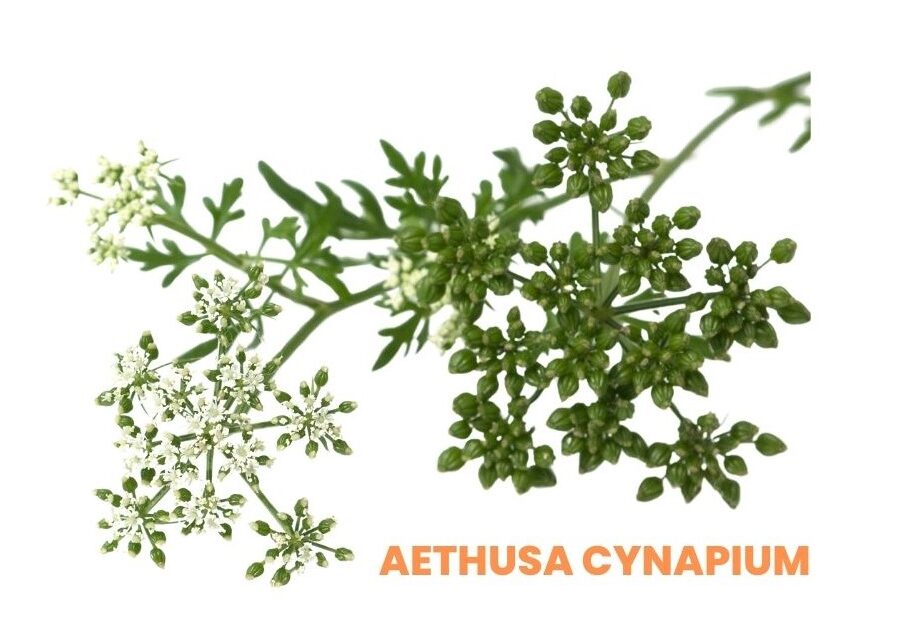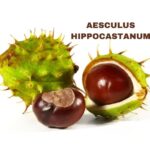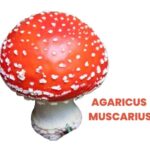Aethusa Cynapium stands out as a prominent remedy for addressing vomiting in children, particularly during the teething process and in hot summer conditions, often associated with an intolerance to milk.
This remedy is notably thirstless and holds significance in the treatment of Cholera infantum. Additionally, Aethusa Cynapium is considered valuable in addressing epilepsy in infants.
SOURCE: Fool’s Parsley
PROVER: Nenning

Table of Contents
ToggleSCIENTIFIC CLASSIFICATION
- Kingdom: Plantae
- Division (or Phylum): Magnoliophyta
- Class: Magnoliopsida
- Order: Apiales
- Family: Apiaceae (Umbelliferae)
- Genus: Aethusa
- Species: Cynapium describe
CLINICAL APPLICATIONS
Aethusa Cynapium finds clinical utility in addressing a variety of conditions including brain fag, Cholera infantum, convulsions, cough, delirium, dyspepsia, epilepsy, headache, hiccough, idiocy, infantile paralysis, intolerance of milk, disorders of the stomach, and vomiting.
SPHERES OF ACTION
- Nervous System: Addressing conditions such as convulsions, epilepsy, and delirium.
- Glandular System: Modulating the activity of glands in the body.
- Mucous Membrane: Affecting mucous membranes in various organs.
- Skin: Demonstrating an impact on the skin.
PATHOGENESIS
Aethusa Cynapium is a potent poison with alarming narcotic properties and paralyzing effects. Its primary therapeutic application is derived from its impact on the stomach.
CONSTITUTION
Physical Characteristics
- The individual exhibits feature indicative of pain and anxiety.
- Additionally, there is a herpetic eruption present at the end of the nose.
- The face appears sunken, with a prominent linea nasalis.
- The child’s physical weakness is profound, rendering them incapable of standing or supporting the head.
WHAT IS CONSTITUTION IN HOMOEOPATHY?
Temperament: Mentally, the patient presents with characteristics of idiocy, confusion, and an inability to think clearly.
WHAT IS TEMPERAMENTS IN HOMOEOPATHY?
Relation with Heat and Cold: The patient exhibits a preference for warmth and is categorized as a “hot” individual.
Miasm: In its acute state, Aethusa Cynapium affects all three miasms.
DOCTRINE OF SIGNATURE OF AETHUSA CYNAPIUM
The Doctrine of Signatures is an ancient concept that suggests plants and substances bear a resemblance to the ailments they can heal or treat.
In the case of Aethusa cynapium, or Fool’s Parsley, its signature characteristics are believed to offer insights into its medicinal properties:
Leaf Appearance: Aethusa cynapium has finely divided, fern-like leaves that resemble the shape of the brain’s convolutions.
This resemblance led herbalists to believe it could treat disorders of the brain and nervous system.
White Flowers: The plant produces small, white flowers that some interpret as a sign of purity and innocence.
This association may suggest its potential use in treating conditions affecting infants and young children, such as colic or digestive issues.
Toxicity: Aethusa cynapium is highly toxic if ingested, causing symptoms such as vomiting, convulsions, and respiratory distress.
In the Doctrine of Signatures, this toxicity may be seen as a warning sign, indicating its potential to address symptoms of poisoning or toxicity in the body.
CHIEF GUIDING SYMPTOMS
- Intolerance of Milk: Aethusa Cynapium patients exhibit an extreme intolerance to milk, whether it be from the mother, cow, or processed sources like bottled or tinned milk. Vomiting occurs, expelling large curds, leading to weakness and drowsiness.
- Teething Indigestion: Particularly in teething children, indigestion manifests with violent, sudden vomiting of frothy milk-white substance or yellow fluid, followed by regurgitation of curdled milk and cheesy matter.
- Regurgitation after Eating: An hour or so post-meal, regurgitation of food occurs, accompanied by greenish copious vomiting, weakness, and prostration, often followed by sleepiness.
- Absent Thirst: A notable absence of thirst is a characteristic feature of Aethusa Cynapium.
- Physical Weakness: Aethusa patients exhibit profound weakness, rendering them unable to stand or hold up their head. Prostration and sleepiness are prominent.
- Anxiety and Pain: The patient displays an expression of great anxiety and pain, often accompanied by sunkenness in the face, with a well-marked linea nasalis, a distinctive characteristic of Aethusa.
- Mental State: Mentally, the patient presents with idiocy, incapacity to think clearly, and profound confusion.
- Epileptic Spasms: Epileptic spasms are marked by clenched thumbs, a red face, fixed and dilated pupils, a mouth filled with foam, and locked jaws. Notably, the eyes are turned downwards, a peculiar symptom of Aethusa.
- Herpetic Eruptions: Herpetic eruptions may appear on the end of the nose.
- Mind: Patients may hallucinate, imagining they see a rat or mouse running across the room. Idiocy, confusion, and facial features expressive of pain and anxiety are common.
- Triggers: Aethusa ailments often arise during teething, hot summer weather, consumption of milk or dairy products, errors in diet, and exposure to poor hygienic conditions.
PARTICULARS
AETHUSA FOR BABIES
Aethusa cynapium is a valuable remedy for babies experiencing vomiting, cholera infantum, and epilepsy.
These issues commonly arise during the teething process in hot summer weather.
The key characteristic is an inability to tolerate milk in any form.
The affected baby is notably weak, unable to stand or hold up its head, and remains profoundly tired and sleepy.
Symptoms
- Vomiting: The baby violently and suddenly vomits large quantities of sour curd-like substances, especially after swallowing milk. This effort is followed by a state of relaxation and drowsiness.
- Dentition and Hot Weather: These symptoms intensify during the teething period, in hot summer weather, and due to indigestion.
- Regurgitation: There is a tendency to regurgitate food about an hour after eating.
- Mental State: The baby appears confused, idiotic, and lacks the capacity to think.
- Facial Expression: Features on the baby’s face express pain and anxiety, with a drawn appearance and a distinctive herpetic eruption at the nose’s end.
Distinguishing from Calcarea ost.
- Sour Vomiting: While both Aethusa and Calcarea ost. may present with sour vomiting of large curds, Aethusa is different.
- Temperament: Calcarea ost. typically has a leucophlegmatic temperament.
- Additional Symptoms: Calcarea ost. may exhibit sour stool, sour sweating, and a sweaty head with open fontanelles.
- Regurgitation: Aethusa shows regurgitation of food about an hour after eating.
- Vomiting Characteristics: Aethusa’s vomiting is copious and greenish.
- After Vomiting: Weakness and prostration with sleepiness follow vomiting in Aethusa.
- Mental and Physical Weakness: Aethusa presents with mental idiocy and significant physical weakness, preventing the baby from standing or holding up its head.
- Facial Expression: Aethusa’s facial features express pain and anxiety more prominently than in Calcarea ost. or Calcarea carb.
Causative Factors
- Issues often arise during dentition, in hot summer weather, and due to milk intolerance.
STOMACH
- Intolerance of milk, leading to immediate vomiting, often in large curds.
- Hunger after vomiting.
- Regurgitation of food about an hour after eating.
- Violent vomiting of a white frothy matter.
- Nausea at the sight of food.
- Painful contraction of the stomach.
- Vomiting accompanied by sweat, weakness, anguish, and distress, followed by sleepiness.
- Feeling of the stomach being turned upside down, with a burning sensation extending up to the chest.
- Tearing pains in the stomach extending to the esophagus.
ABDOMEN
- Coldness internally and externally, with aching pain in the bowels.
- Colic, followed by vomiting, vertigo, and weakness.
- Abdomen tense, inflated, and sensitive.
- Sensation of bubbling around the navel.
STOOL
- Undigested, thin, greenish stool, preceded by colic, with tenesmus, and followed by exhaustion and drowsiness.
- Cholera infantum: characterized by cold, clammy, stupor, staring eyes, and dilated pupils.
- Obstinate constipation, feeling as if bowel action is lost.
- Choleraic affections in old age.
CHOLERA INFANTUM
- Onset is sudden, with the child lying stretched out in an unconscious condition, with fixed and dilated pupils and eyes turned downwards.
- Sunken face and well-marked linea nasalis.
- Great intolerance of milk, which is vomited out in large sour curds.
- After vomiting, the baby falls completely prostrated and exhausted.
- Violent, sudden vomiting of frothy white substance resembling milk, sometimes green and copious.
- Inability to retain anything in the stomach.
- Symptoms of collapse may supervene, including greenish, liquid, slimy, and undigested stool, often profuse with green mucus.
- During and before stool, colic and convulsion may occur.
- After stool, weakness and prostration with sleepiness are prominent.
- Worse in the morning.
Causation
- High temperature of summer, errors of diet, dentition, and bad hygienic surroundings.
CONVULSIONS OR EPILEPSY WITH AETHUSA
Aethusa presents distinctive symptoms in the context of epileptic convulsions, setting it apart from other remedies.
Key Characteristics
- Eyes Turned Downwards: One peculiar symptom is the turning of the eyes downwards during convulsions, a notable feature not commonly seen with other remedies.
- Facial Changes: In severe cases, the face may exhibit sunkenness, particularly marked by the well-defined linea nasalis.
- Spasms: The spasm is intense, accompanied by clenched thumbs, a red face, fixed and dilated pupils, locked jaws, and foaming at the mouth.
- Pulse: Following the spasm, the pulse is small, quick, and hard.
- Post-Spasm Effects: After the convulsive episode, the individual experiences significant weakness and prostration, coupled with a strong inclination towards sleepiness.
GENERAL MODALITIES
Aggravation
- All complaints worsen after eating or drinking.
- Exacerbation in hot summer weather.
- Aggravation from milk or milk in any form.
- Aggravation after vomiting.
- Worsening after stool.
- Aggravation after spasm during the period of dentition.
- 3 a.m. to 4 a.m. aggravation.
- Evening aggravation.
Amelioration
- Improvement from covering.
- Relief in open fresh air.
- Better by the seashore.
- Amelioration with rest.
- Improvement in the company of others.
- Tight bandage on the head provides relief.
REMEDY RELATIONSHIP
Similar to
- Antimonium crudum
- Arsenicum album
- Calcarea carbonica
Complementary to
- Calcarea carbonica
Antidoted by
- Vegetable acids
Antidotes
- Opium
- Aconitum napellus in inflammatory conditions
TREATMENT APPROACH
- Aethusa Cynapium is indicated in the acute stage, followed by an antipsoric remedy like Psorinum or Sulphur for complete cure.
POTENCY RANGE: Third to thirtieth potency.
FREQUENTLY ASKED QUESTIONS (FAQS)
- What is Aethusa Cynapium, and what are its clinical applications?
- Aethusa Cynapium is a homeopathic remedy derived from Fool’s Parsley. It is primarily used for conditions such as vomiting in children during teething, Cholera infantum, convulsions, and various digestive and neurological issues.
- In what clinical conditions is Aethusa Cynapium effective?
- Aethusa Cynapium is known to be effective in brain fag, Cholera infantum, convulsions, cough, delirium, dyspepsia, epilepsy, headache, hiccough, idiocy, infantile paralysis, intolerance of milk, disorders of the stomach, and vomiting.
- What are the spheres of action of AEthusa Cynapium in the body?
- Aethusa Cynapium acts on the nervous system, glandular system, mucous membrane, and skin. Its pathogenic effects are particularly pronounced in the stomach.
- How does Aethusa Cynapium impact the stomach, and what constitutional characteristics does it exhibit?
- Aethusa Cynapium causes intolerance of milk, leading to immediate and violent vomiting, often in large curds. The patient may have a sunken face, a well-marked linea nasalis, and profound physical weakness. Mentally, the patient may exhibit idiocy, confusion, and an inability to think clearly.
- What distinguishes Aethusa Cynapium in treating babies?
- Aethusa Cynapium is valuable for babies experiencing vomiting, cholera infantum, and epilepsy during teething in hot summer weather. The key characteristic is the baby’s inability to tolerate milk in any form, leading to violent and sudden vomiting of sour curds.
- How does Aethusa Cynapium address convulsions or epilepsy, and what are the key symptoms?
- Aethusa Cynapium presents distinctive symptoms during convulsions, including the peculiar turning of the eyes downwards, spasms with clenched thumbs, a red face, locked jaws, and foaming at the mouth. Following the spasm, the individual experiences weakness and prostration.
- What are the general modalities of Aethusa Cynapium?
- Complaints worsen after eating or drinking, in hot summer weather, with milk consumption, after vomiting, after stool, and during the period of dentition. Improvement is observed with covering, in open fresh air, by the seashore, with rest, in the company of others, and with a tight bandage on the head.
- Which remedies are similar to Aethusa Cynapium, and what substances can antidote it?
- Similar remedies include Antimonium crudum, Arsenicum album, and Calcarea carbonica. Calcarea carbonica is complementary. Aethusa Cynapium can be antidoted by vegetable acids and is itself an antidote to Opium and Aconitum napellus in inflammatory conditions.
- What is the recommended dosage for Aethusa Cynapium?
- Aethusa Cynapium is typically administered in the potency range of third to thirtieth potency in homeopathic practice.
- How should Aethusa Cynapium be approached in treatment?
- Aethusa Cynapium is indicated in the acute stage, and for complete cure, it is recommended to follow it with an antipsoric remedy like Psorinum or Sulphur. The attack duration may vary from a few hours to several weeks.
Note: This information is for educational purposes and should not be considered medical advice. Consult a qualified homeopathic practitioner for personalized recommendations.













Leave a Reply